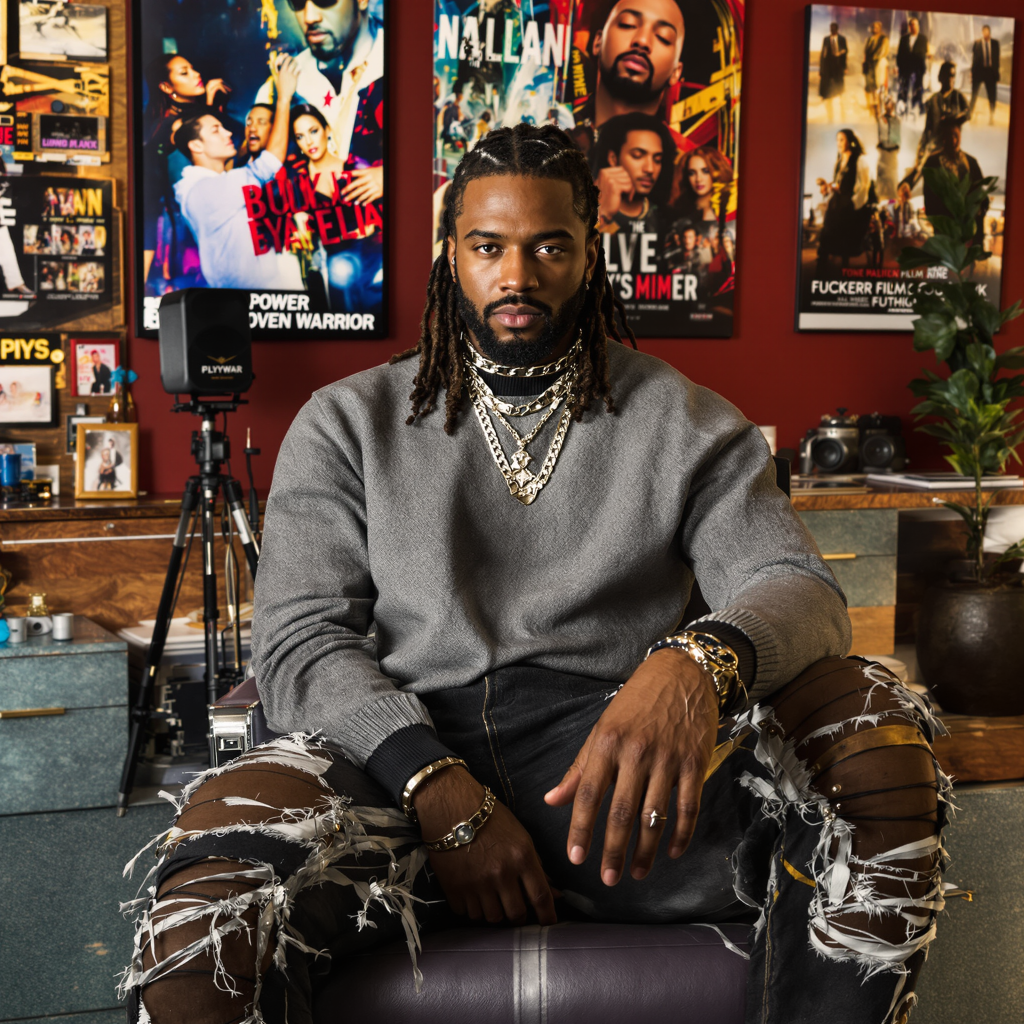
Introduction: How to Build an Independent Film and Video Platform
Black excellence is more than a dream—it’s a movement. Imagine a Black-owned film and entertainment platform that rivals Netflix, Amazon Prime, and even YouTube for music videos.
A single stage for independent films, music videos, and original series driven by AI. The opportunity is now, and we have the power to shape culture and create wealth.
This is your step-by-step guide to starting an AI-powered independent film company and creating an advanced film platform for Black ambitious creatives to shine.
This power guide will take you from business set-up to marketing strategies, giving you everything you need to bring this vision to life.

Step 1: Laying the Foundation: Business Setup
In this section: We will go deep into laying the foundation for your independent film platform.
Setting up your film business correctly is crucial to ensure everything from funding to marketing runs smoothly. Allowing you to focus on creating impactful content.
Business Name and Structure:
- Choose a name that captures innovation, power, and culture. Make it resonate with your vision (e.g., “Urban Reel Studios” or “Mogul Vision Media”). Consider how the name reflects your target audience, the community you serve, and the impact you want to create. Ensure it’s memorable, easy to spell, and available across all digital platforms.
- Register the business as an LLC or S-Corp to protect your assets and make tax filings smoother. The LLC keeps it flexible, while the S-Corp adds extra tax advantages and can be beneficial, if you’re planning to pay yourself a salary. Consult a professional to determine which fits your business goals.
Steps to Get Started:
- Domain Name: Secure your domain name on platforms like Bluehost Your platform needs a name that’s easy to remember and embodies your mission. Make sure the domain is available and try to use a .com as it’s more recognized and trusted by users.
- Business Bank Account: Set up a dedicated bank account to keep everything legit and organized. Choose a bank like Chase Bank that offers benefits to small businesses like no monthly fees, cash-back rewards, or better loan rates.
- DUNS Number: Get a DUNS Number from Dun & Bradstreet to start building business credit. It’s crucial for securing future funding, signing supplier contracts, and appearing more legitimate to potential investors.
- EIN (Employer Identification Number): Register your business with the IRS for tax purposes. This number is essential for everything financial—from opening a business bank account to hiring employees.
- Business Plan: Write up a strong business plan that covers your target market, competitors, pricing strategy, platform features, and projections for growth. Include specific goals (like audience reach, platform growth, and content acquisition timelines) and outline potential challenges with planned solutions.
- Licenses and Insurance: Media and production-specific insurance is a must to cover legal liabilities. Also, get content licensing agreements ready for any third-party films or music videos to avoid copyright issues.
A solid foundation leads to limitless growth. Set your groundwork right and build an empire that endures. One that stands resilient amidst challenges and adapts as you scale. Every detail in the setup phase will pay off in the long run, providing stability and a strategic edge.

Step 2: Funding and Start-Up Costs
In this section: We’ll explore how to secure the necessary funds for your film platform and detail the costs involved.
Funding is the backbone of your business—how you secure it will dictate the direction, speed, and scale of your success.
Powerful Funding Sources:
- Grants for Black Entrepreneurs: Start by applying for grants that support Black-owned tech or media startups. There are countless funds out there looking for new voices—some well-known ones include The Black Founder Startup Grant, Comcast RISE, and New Voices Fund. Research what’s available locally and nationally, and apply to as many as you qualify for.
- Business Loans: Use your DUNS number to apply for low-interest business loans. The SBA (Small Business Administration) offers several funding programs specifically designed for minority business owners. Look into microloans if you’re seeking smaller amounts, or SBA 7(a) loans for larger, long-term funding.
- Crowdfunding: Platforms like Kickstarter or Indiegogo are great ways to involve the community, pitch the idea, and gain financial support. Storytelling is crucial—make a compelling video showcasing your mission, the impact on the community, and why people should contribute.
- Angel Investors: Pitch your project to high-net-worth individuals who believe in your mission. Attend pitch events, leverage LinkedIn for outreach, and create an impressive pitch deck that captures the scale of your vision and the potential returns for investors.
Start-Up Costs Breakdown:
- Platform Development: Building an AI-driven platform costs anywhere from $50,000 to $200,000 depending on features. Consider starting with an MVP (Minimum Viable Product) to keep initial costs lower and add features as your subscriber base grows.
- Content Acquisition: Allocate at least $50,000 to buy rights for independent films, music videos, and exclusive content. You might want to look at negotiating deals where you pay a smaller upfront fee in exchange for a revenue share.
- Marketing: You’ll need at least $20,000 for a robust launch campaign. Think about a combination of digital ads, community events, social media campaigns, and press releases to create a buzz around your launch.
- Miscellaneous: Office equipment, insurance, initial legal fees ($10,000 to $15,000). Include website hosting costs, server fees, and tech support to maintain a seamless user experience.
Funding isn’t just about cash. It’s about belief in your mission. It’s about convincing others to share that belief and backing it up with a clear, focused plan. Beyond the numbers, your ability to articulate your vision, demonstrate its impact, and prove its profitability will be what truly sets you apart. Leverage every opportunity to build allies who believe in your goals and ensure they see the long-term potential.

Step 3: The Dream Team: Assembling Your Crew
The people you bring into your business will make or break your success.
This section details how to assemble the perfect crew to support your film platform—from filmmakers and scriptwriters to tech experts and marketing specialists.
Key Roles You Need:
- Film Directors: Seek independent directors who have an edge and unique voices. Check film festivals, Vimeo, and YouTube for standout projects that align with your brand’s vision.
- Scriptwriters: Connect with scriptwriters on platforms like Fiverr or hire through writing schools and film programs. Consider holding a contest for short film scripts—not only will this generate buzz, but it will attract raw talent to your platform.
- AI Developers: You need tech-savvy people skilled in AI integration, streaming services, and building user-friendly interfaces. Post on tech job boards like Stack Overflow or LinkedIn Jobs and look for those who have worked in entertainment or streaming projects before.
- Production Crew: Lean on freelancers for your first few productions to keep costs flexible. Sites like Upwork, Mandy.com, and ProductionHub are great for finding on-demand production talent.
- Marketing Wizards: Hire professionals who know digital marketing and understand the culture. They should have experience creating viral content, understanding analytics, and building community engagement.
Finding Talent:
- Online Platforms: Fiverr, Upwork, and LinkedIn are great for finding independent filmmakers, scriptwriters, and marketing specialists. Additionally, look into Behance for creatives with a portfolio of relevant work.
- Film Schools and Festivals: Attend Black film festivals, like the Pan African Film Festival or American Black Film Festival, and connect with talented filmmakers who are passionate about telling diverse stories.
- Community Partnerships: Partner with HBCUs and other Black cultural institutions to source fresh talent. Consider creating an internship or mentorship program to bring in young creatives while contributing to the community.
You’re only as strong as your team. Assemble people who share your vision, bring the hustle every day, and elevate your mission. The right team will challenge, inspire, and push the boundaries of what’s possible. Turning your dream into reality through collaboration and relentless dedication.

Step 4: Building the AI-Driven Platform
This section will cover how to build the AI-driven platform that will form the core of your business.
From technology requirements to the benefits of AI integration. We’ll explore how to create a user-friendly, scalable, and efficient platform.
Tech Requirements and AI Benefits:
- AI for Personalization: AI will analyze user behavior to recommend films and music videos based on their tastes. Think Netflix’s algorithm but for an independent Black platform—tailored and cultural. AI will help ensure users are presented with content that resonates deeply with them. Improving engagement and reducing churn.
- Content Upload System: Create an easy-to-use portal for other filmmakers to upload their films. This system should handle large file uploads seamlessly, and automatically process different video formats to ensure compatibility with all devices. Implement an approval system to maintain high-quality content standards.
- Payment Gateways: Use PayPal, Stripe, or Square for easy subscription payments and content purchases. Ensure secure transactions with SSL certificates and consider adding cryptocurrency options for those preferring decentralized payment systems.
- Analytics Dashboard: Include a dashboard to help content creators see real-time data on viewer engagement, allowing them to refine their content. This transparency will help build loyalty among creators who want to improve their craft and maximize viewer satisfaction.
Benefits of an AI-Driven Platform:
- Efficiency: AI takes over routine tasks like sorting, tagging, and recommending content. It also handles customer support through chatbots, providing immediate answers to subscriber questions.
- Scalability: AI allows the platform to grow without needing a huge increase in staff. Automate customer service, content tagging, and even basic video editing, reducing the need for manual intervention.
- Cost Management: Save on labor costs with AI handling customer service queries, content organization, and providing advanced analytics that drive user engagement without manual data analysis.
Technology is your secret weapon. Leverage AI to boost efficiency, slash costs, and provide a personalized experience that sets your platform apart. Invest in technology that grows with you, and always stay ahead by exploring new ways to enhance both user and creator experiences.

Step 5: Pricing Strategy for Subscribers and Creators
Pricing is everything—too high, and you lose subscribers; too low, and you undervalue your content.
In this section: We’ll explore how to structure pricing for both subscribers and content creators in a way that ensures profitability and platform growth.
Subscription Model:
- Basic Tier: $9.99/month for standard access (limited content). Offer 720p quality streams, with ads, and limited content to entice viewers to upgrade.
- Premium Tier: $14.99/month for full access, exclusive premieres, no ads, and access to offline viewing. Offer HD or 4K streams, exclusive content, and member-only events to add value.
- Annual Discount: Offer a discount for those who pay for the year upfront (e.g., $120/year instead of $144), which will incentivize longer-term commitments.
Content Upload Pricing:
- Independent Filmmakers: Charge a $100 one-time fee per film to upload to the platform. Offer a revenue-sharing option to entice more creators—50/50 on rental fees or ad revenue generated from their content.
- Music Labels and Videos: Charge between $300 and $500 per music video for a six-month listing, with premium placement options available (like featured playlists or home page banners).
- Revenue Share Model: Offer flexible deals—some filmmakers may prefer a lower upfront cost in exchange for a higher percentage of the back-end revenue.
Price smartly—make it accessible for users but rewarding enough for creators to flock to your platform. Strike the balance between affordability and sustainability to ensure everyone feels valued, and consistently reassess pricing strategies to adapt to market changes and evolving audience needs.

Step 6: Marketing and Growth Strategy
Marketing will determine how quickly your platform gains traction.
This section will discuss key strategies to market to both the public and filmmakers, build a loyal audience, and grow your platform to its full potential.
Marketing to the Public
- Social Media Power: Use Instagram, TikTok, and YouTube to create teasers, behind-the-scenes footage, and trailers. Engage directly with potential viewers using polls, Q&A sessions, and by highlighting community feedback. TikTok challenges around your content can boost virality.
- Community Activations: Hold launch events in cultural hubs—think block parties, outdoor film screenings, and neighborhood pop-ups in areas that inspired the platform. Create merchandise (like hats, shirts) and give them away at events to spread the word.
- Free Trials: Give new subscribers a free month to hook them in. Encourage signups by offering exclusive previews or the chance to attend virtual Q&A sessions with directors and actors.
Marketing to Film Companies
- Direct Outreach: Connect directly with independent filmmakers through emails, social media, and creative circles. Share the benefits—they keep more profits and reach an audience who wants diverse stories. Create personalized pitches showing how your platform’s audience is perfect for their content.
- Industry Conferences: Attend events like the American Film Market (AFM), Sundance, and Tribeca to pitch your platform. Have professional marketing materials and demos ready—showcase your AI-powered platform’s unique benefits for creators.
- Revenue Sharing Deals: Offer popular film companies a favorable revenue split for hosting their films. Highlight how they’ll gain access to a niche audience that’s eager for authentic, diverse stories.
Marketing Tools and Strategies:
- Email Marketing: Send newsletters with new releases, filmmaker interviews, and industry news to keep your audience engaged. Segment your lists to send targeted emails—some to subscribers, others to filmmakers or potential partners.
- Influencer Collaborations: Partner with influencers and celebrities who align with your mission to boost visibility. Use Instagram and TikTok influencers to create original content that promotes the platform and its exclusive films.
- Guerilla Marketing: Hit the streets. Flyers, murals, graffiti-style marketing—create buzz that can’t be ignored. Commission artists for murals in neighborhoods with vibrant cultural scenes. Use QR codes on all physical marketing to drive viewers directly to the platform.
- Content Marketing: Blog posts, interviews, and BTS (behind-the-scenes) stories are essential to give your audience a reason to visit your site regularly. Highlight community impact, the stories behind the films, and why diverse storytelling is needed.
Marketing is where hustle meets strategy. Capture hearts, build hype, and keep your content unforgettable. Consistent effort and genuine engagement will cultivate a loyal audience, turning followers into lifelong supporters who share in your vision. Keep pushing boundaries, and always find new, authentic ways to connect.

Step 7: Ad Revenue and Sponsorship Opportunities
Intro: Monetizing your platform through advertisements and sponsorships can provide a steady revenue stream, helping to cover operational costs and fund new content.
In this section, we’ll explore how to attract advertisers, set ad pricing, and bring in sponsors who align with your platform’s vision.
Ad Revenue Streams:
- Banner Ads: Incorporate banner ads on your platform’s homepage or during content browsing. Charge anywhere from $500 to $5,000 monthly depending on ad placement and platform traffic.
- Video Ads: Offer pre-roll and mid-roll video ad slots during films and music videos. Pre-roll ads can be sold for $15-$30 per CPM (cost per thousand impressions), while mid-roll ads typically go for $20-$40 per CPM.
- Sponsored Content: Partner with brands to create content that subtly features their products. This could include behind-the-scenes interviews, sponsored Q&A sessions, or themed short films. Sponsored content can generate significant revenue, especially if tied to premium brands.
- In-App Ads: If developing a mobile version of your platform, in-app ads can be another revenue source. Integrate native ads that blend in well with the browsing experience, reducing user frustration.
Sponsorship Opportunities:
- Event Sponsorships: Secure sponsors for special events like online premieres, film festivals, or community screenings. Local businesses and cultural brands often want to be involved in events that uplift their community. Charge sponsors between $5,000 and $20,000, depending on the event’s scale and reach.
- Platform Sponsorships: Allow larger companies to sponsor a section of your platform (e.g., “Presented by…” branding on certain collections or genres). Corporate sponsors may pay upwards of $50,000 for these opportunities, especially if it provides ongoing visibility.
- Exclusive Series Sponsorship: If you’re producing original series, consider bringing in sponsors to co-brand the show. This could include product placements or branded credits, which not only finance production costs but also increase your platform’s legitimacy.
Attracting Advertisers and Sponsors:
- Audience Insights: Use analytics to showcase the value of your platform’s audience to potential advertisers. Highlight demographics like age, interests, and engagement metrics—especially emphasizing a loyal, culturally connected viewer base.
- Brand Partnerships: Approach companies whose values align with your mission—focus on brands that support Black culture, creativity, and empowerment. Pitch them on how your audience overlaps with their target market.
- Ad Packages: Create tiered ad packages that include different types of advertising (e.g., video ads, banner ads, sponsorships) to provide variety for companies of different sizes. Packages can simplify the buying process and encourage larger commitments.
Ad revenue and sponsorships aren’t just income—they’re partnerships that align your brand with companies that share your values. By providing advertisers with clear audience insights, impactful ad placements, and cultural authenticity. You’ll establish lucrative relationships that benefit both sides. Monetize smartly and make sure every sponsor enhances the experience for your audience, not detracts from it.

Conclusion: From Dream to Dominance
Creating an AI-driven, Black-owned independent film company is more than a business—it’s a cultural revolution. It’s about creating a stage for our stories, on our terms, and using technology to amplify our voices.
From building a solid business foundation to executing a flawless marketing strategy, every move you make puts you closer to owning the future of entertainment.
This platform is for shifting narratives, uplifting voices, and building generational wealth. Step into your power, rise as a mogul, and redefine what’s possible.



















